For the 2002 World Cup, hopes were largely placed on the Argentina of Marcelo Bielsa who had achieved quite important feats before in his country such as the consecutive First Division championships with Newells in his first experience as a coach, or later the one he won with Vélez the same year that he would sign with the national team.
Four years later, that team would be eliminated from the World Cup.
The biggest disappointment would occur in the group stage, and within that team was Matías Almeyda.
Much of the style of his former coach has been adapted to his own style as a manager.
He has had challenging stages in his career.
Even the first was a tough River Plate that had been relegated to the Argentine second division.
There, he was able to get first place but later he would be terminated due to poor results, as in his next position at Banfield, after promoting them in his second season with them.
Then, with experiences in Mexico and the United States, the first one in Europe arrived, specifically in Greece with AEK Athens.
The season is off to a great start for him and his team.
They are seconds behind Panathinaikos, with 38 points and one of the most aggressive defences of the entire tournament.
That is why we have put the magnifying glass to carry out a tactical analysis that will be a team scout report on the man-oriented high-pressing Matías Almeyda has established at AEK Athens and finding similarities within his tactics at the old teams he had managed.
Intense man-marking high-pressing
What is most recognisable within Bielsa himself and his disciples is the intensity and strictness of the man-marking pressing.
A fairly high defensive line that seeks to steal in the last third to create chances or win the ball in areas oriented by themselves and then retain the ball or attack quickly in different situations.
This is something that is extremely clear within not only AEK Athens, but Almeyda’s philosophy, which we have been able to see throughout the teams that he has coached in his career.
In the Greek team, he manages a rather intense idea but with certain principles that constantly force his rivals to generate back-passes, or side-passes that do no damage, as well to create nervousness and doubts for his enemies in order to later win the ball back.
All this is seen in many of their defensive plays where they wait for the opponent who tries to build up with the ball.
However, they also show a lot of this aggression in second-ball plays.
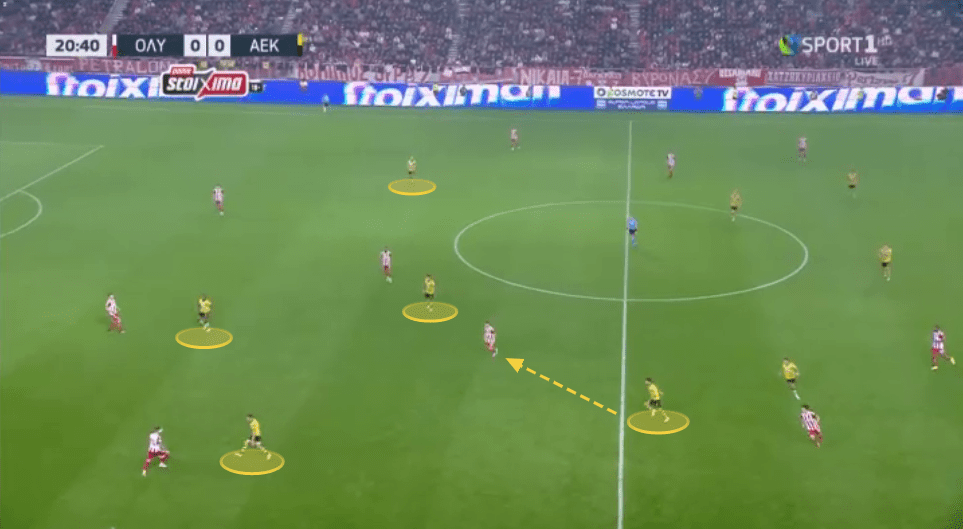
The important thing for Almeyda is that it doesn’t really matter which opponent they are playing against, the idea remains the same.
He may be the last classified, like the first, but both will seek to defend him in the same way, covering all the passing options on the field when the rival holder has the ball and must think about what decision to make.
The first figure above us shows a very clear example against Olympiakos.
In a search for game creation by those led by Michel, the high pressing is very clear, not only because of their positioning almost in the half-way-line, but also because of how they are marking: man-oriented, with great intensity with which they travel from one zone to another, covering all the spaces so their rivals don’t progress.
As we can see, the ball was played on the right side of the pitch, so this is the strong side that Olympiakos is handling right now.
One of the principles within this defensive style of Almeyda is that strictly tight markings do not always have to exist.
While some do remain in said positioning and role, others leave a small space for when the pass is activated and pull the trigger with mini-runs that with aggressive jumps they will seek to cut, before he receives or on his first touch.
If we take a look at the image, all the rival players are taken, even on the far side of the ball, and one of the wingers keeps an eye on two players in case of a side change.
If they are looking for a long ball to the full-back, he is there, and if they play the ball to the centre-back, he’s attentive to jump quickly and close down spaces.

In this second example, against Volos NFC, the sixth-ranked side in the Greece Super League, we can see how everything is executed in the same way again in an attempt to build up from them.
One of the curious things is that many of these steals or forced errors committed by the teams that play against AEK Athens are from the wing, where Almeyda’s team have even managed to score after recovery.
We can see how the ball has been forced towards the right side of Volos.
The pressure from one of the forwards was, with his body posture oriented towards the said wide area, one that we have previously seen before against Olympiakos.
There, the opposition full-back has few options: Throw the long ball and give away possession, or reverse everything with one of the centre-backs or the goalkeeper.
But it’s going to be the same thought for each of them who have the ball and look up for options as they’re all marked.
One of the similarities also in the previous image is that on the strong side of the rival ball, they accumulate up to four players, one staying on the other side, normally being a winger who tries to cover the full-back, always leaving space to press the trigger at the right time and surprise him, rather than staying tight.
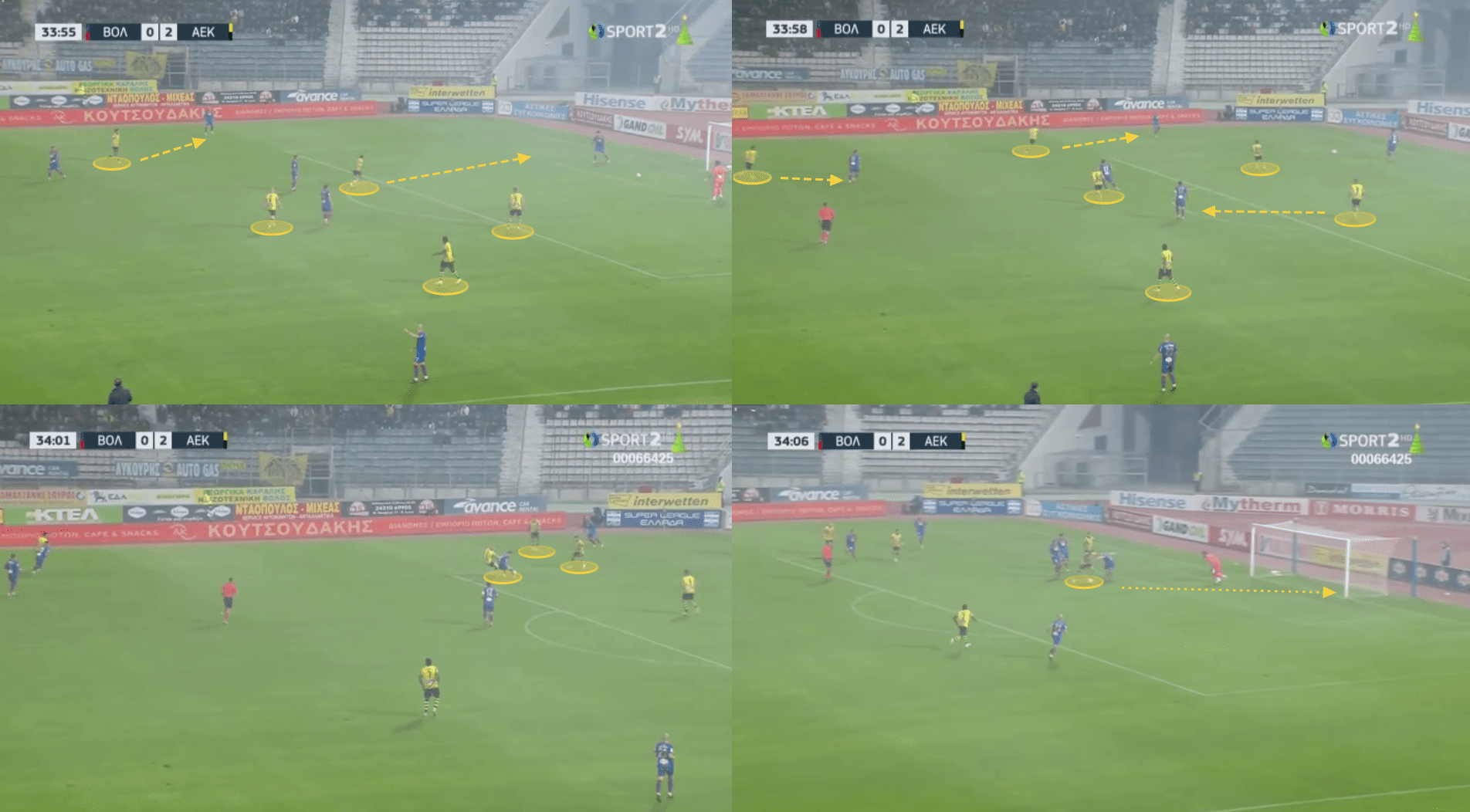
The dangerous plays that they generate after stealing the ball are always quite regular within Matías Almeyda’s team.
Against Volos, one of the goals scored was thanks to the high pressure and the marking of the man made by them.
Against goal kicks, two forwards position themselves exactly on the edge of the box.
Its form is a kind of 4-4-2 that shifts around the movements of the rivals since the role of the players are not zonal and it all depends on where the rival looks to receive.
After taking it, one of these forwards jumps to the receiver, his job is to guide the ball-holder, normally a centre-back, with his run, towards one of the rival’s full-backs.
In this case, again, it is performed towards the right zone.
When the ball is played many things begin to change.
Little by little, the winger is getting closer to the side that is oriented towards the rival team, while another of the forwards takes a midfielder as a reference.
One of the midfielders of the rival double pivot tries to appear diagonally to the player on the ball, the full-back, something that an AEK player is aware of and is marking this movement.
That passing line is the only one the full-back has since the one offered to him to play on the wide channel forward is also marked.
When making this pass diagonally, AEK successfully recovers the ball with a tackle, which in about three seconds ends in a 1v1 against the goalkeeper and a goal.
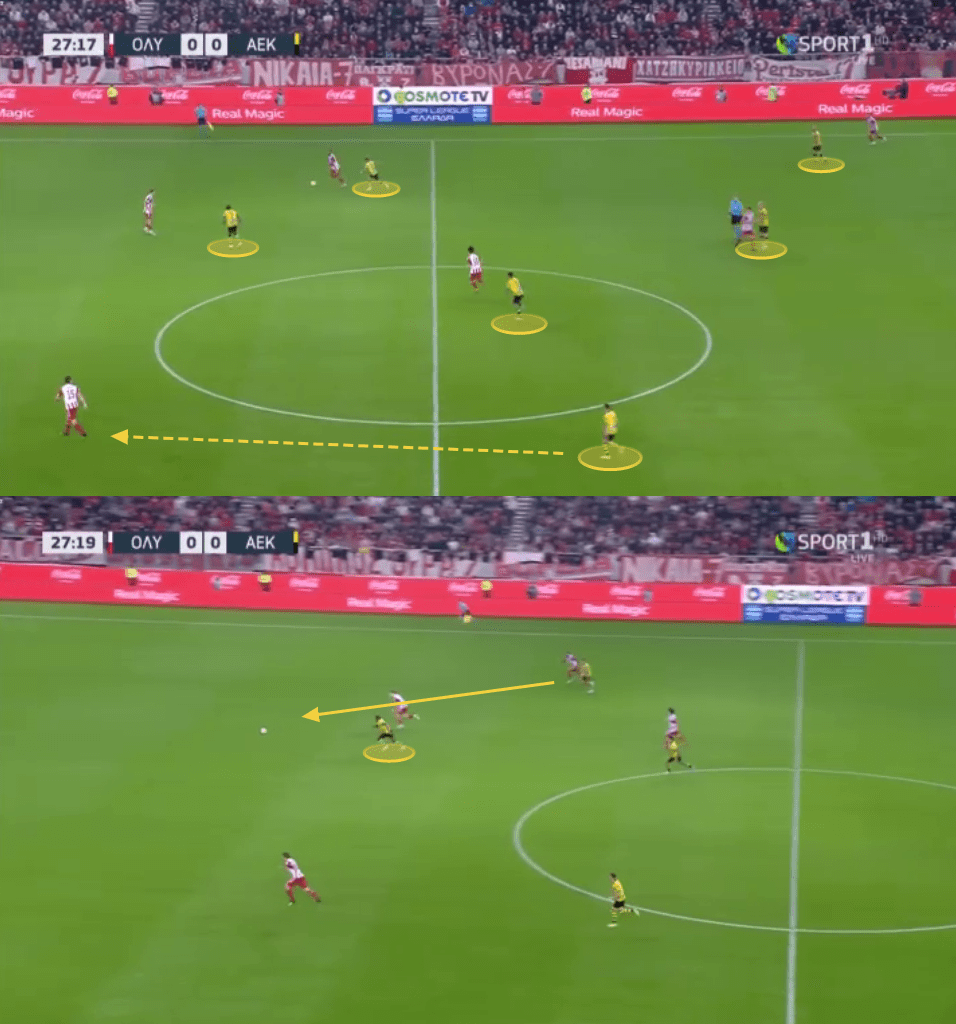
Another example of a play generated by forcing and covering all passing options is this one against Olympiakos in their recent league draw.
Where AEK Athens block potential nearby players, and with the idea of Michel’s team doing ground build-ups, they decide to move it from side to side trying to create space but it doesn’t happen, and they start to stress out.
In this case, the holder of the ball, given the many blocked options, will decide to carry out a back-pass for his goalkeeper.
One of the keys to this decision is that even with a player totally free on the other side, it was a kind of pressing trap to make the ball move there and the player on the far side of the pressing will try to anticipate the pass.
Therefore, he takes the execution towards the goalkeeper.
The pass is poorly executed, an error forced by AEK, which throws the striker in a 1v1 situation against the goalkeeper but he was quick to jump to cut and clear the ball out.
However, it should be said that man-marking has its cons and it has been seen in AEK, with some rival progressions trying to move Almeyda’s team with rotations and freedom of movement with many players in order to create quick combinations that cannot be cut off.
Luckily for the Argentine coach, his last line has experienced a solid moment together with his goalkeeper as well.
They have conceded just 7 goals in 17 games, an impressive number for a very aggressive and risky side.
Data and similarities with his old teams
Arriving at the last part of the analysis, let’s take a look at the data.
AEK Athens has accumulated a PPDA of 5.75.
This is an extremely low number that indicates how aggressive and positive the high-pressing that Almeyda has brought to the team has been.
If we compare with the best five leagues in Europe and even add others like the Eredivisie, Scottish Premiership, the EFL Championship or the Primeira Liga, their PPDA is still the lowest among all, a compelling statistic about his style and dynamics that he looks for within his tactics.
As we can see below in the pizza chart of AEK’s season, they are one of the best teams in the league, not only for what they have done defensively but as well for scoring and creating chances, without underestimating this aspect of Almeyda’s team, which he looks to be very direct in his attacking ideas, being the second teams with the most long-balls attempted.
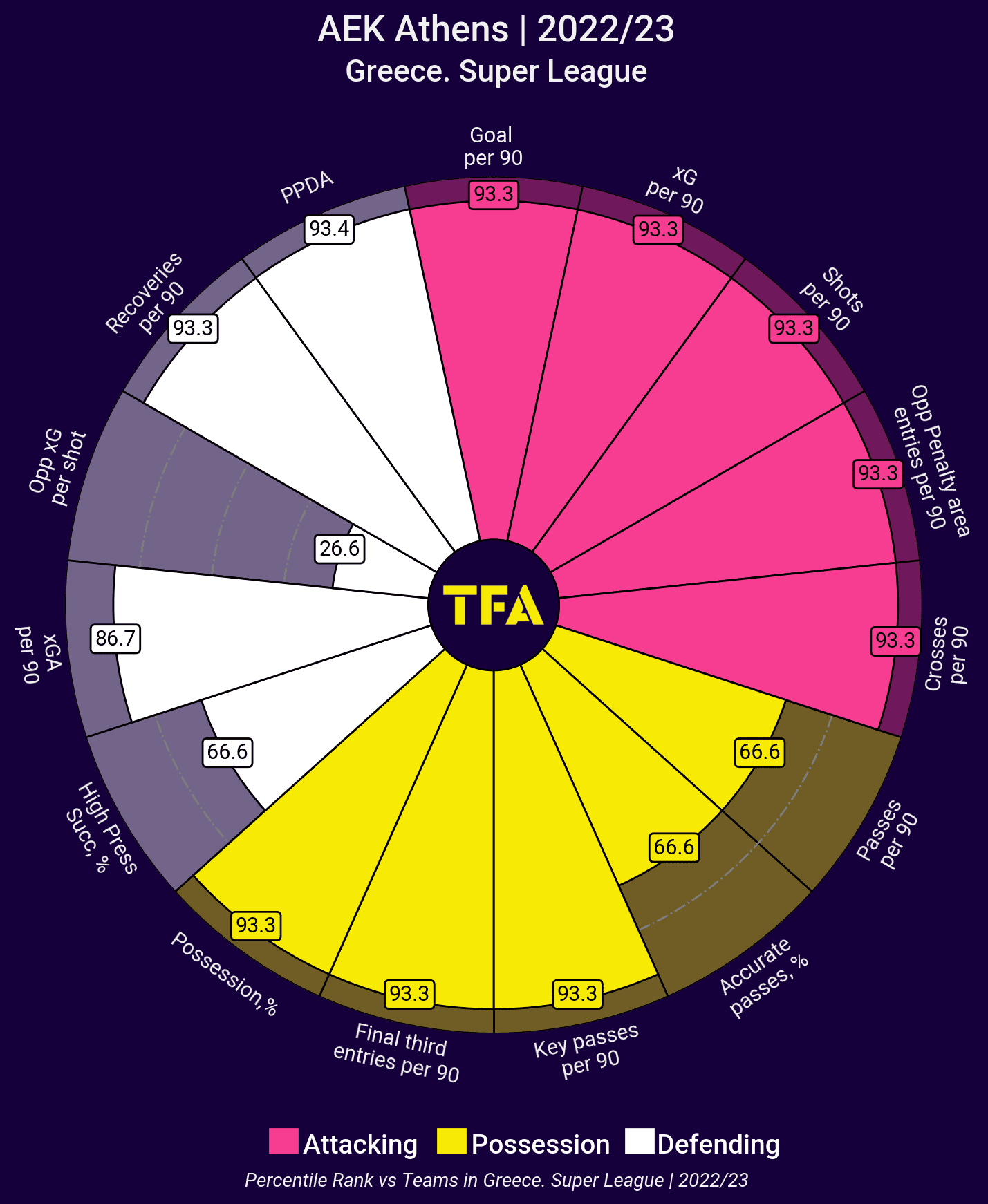
As we can see in the map of defensive actions that we have above, AEK maintains an extremely high line in the regularity of the league.
With a high number of actions in the last rival third.
But as we have already mentioned, this is not something we have only seen at AEK Athens.
For example, in the San José Earthquakes of MLS, they always managed to be one of the most aggressive teams in the US championship despite not having the strongest squad to grow with.
We are going to take the time to show the similarity in the pressure of the team that he led between 2019 and the first months of 2022.
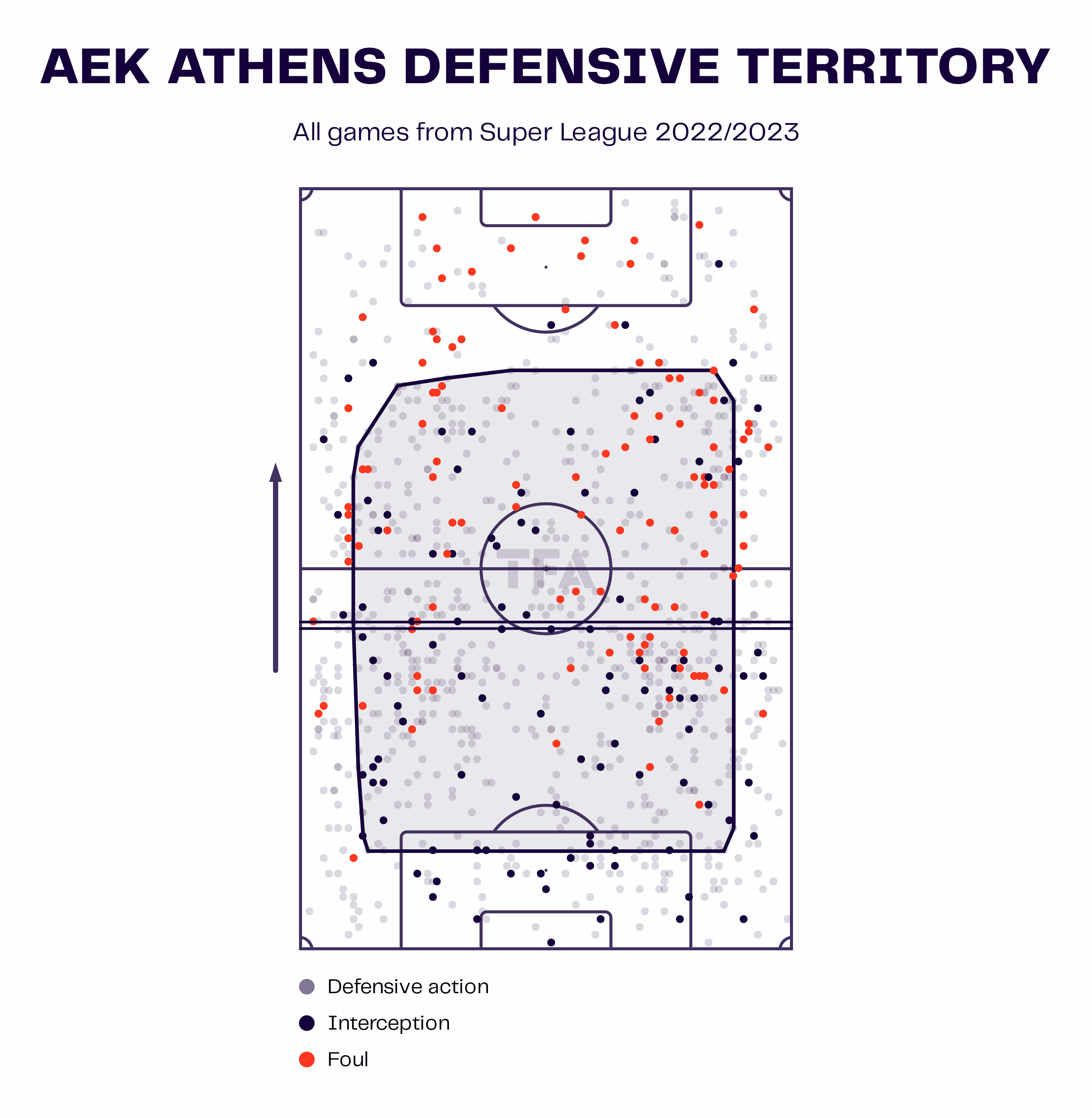
As we can see in the figure below us, Almeyda’s San José Earthquakes took a very similar stance to what they have been doing at AEK Athens.
Faced with the opponent’s build-up, the mini-runs of the players pulling the trigger and directing the opponent to move the ball towards a wing were also a constant in the American team.
Subsequently, we can see how, once again, the error seeks to force it onto the opponent’s right wing, where they accumulate up to four players marking the man but with this principle of leaving a space to pull the trigger and jump aggressively to anticipate the play, something that many high-pressure coaches prefer, rather than marking so tightly.
These pressing traps are the description of how the Argentine wanted to carry out his tactics within each of his sides.
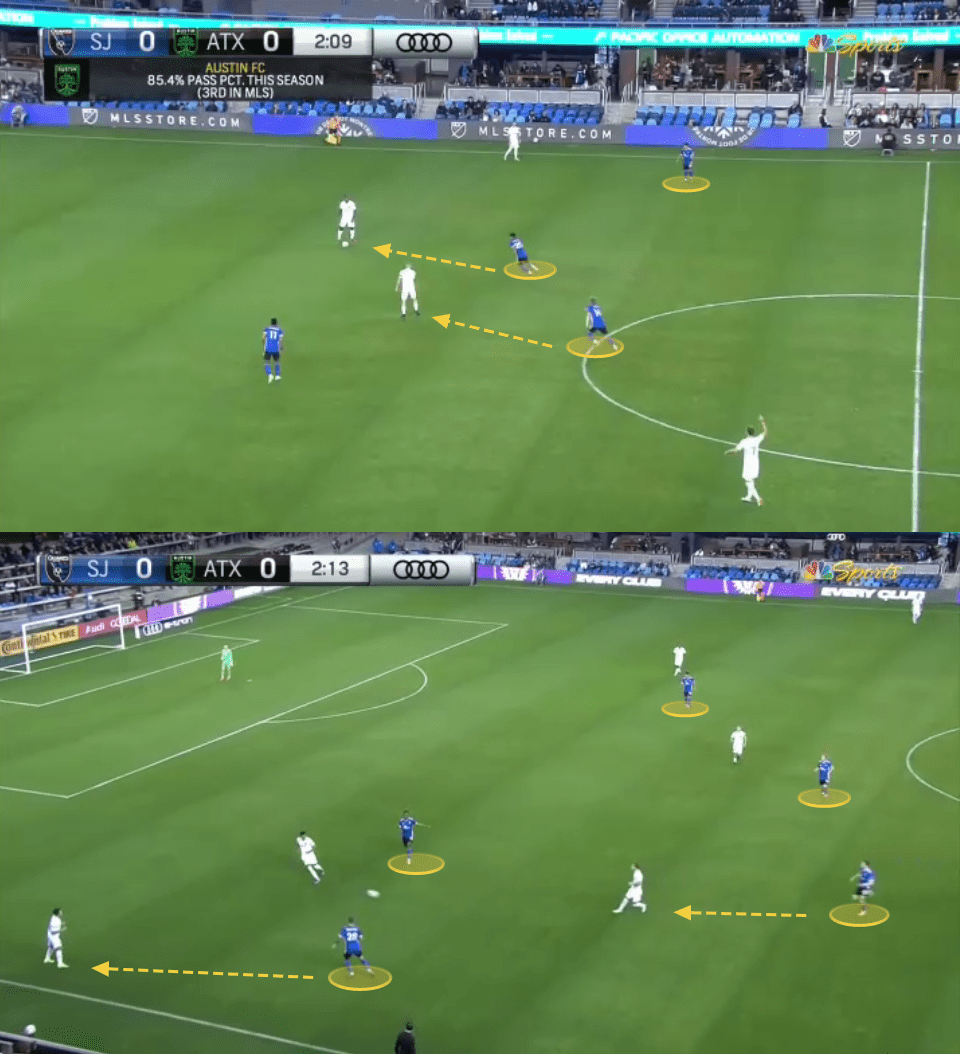
Finally, we take as an example one of his best teams, Guadalajara from the 2017 Liga MX, with which he was champion of the tournament.
We can see the similarity in their pursuit of a high line and intense pressing in the final third of the pitch.
In fact, if we review the statistics in terms of PPDA, Matías Almeyda’s teams such as the San José Earthquakes or Guadalajara in each season that he was in charge were among the ones that pressed the most and best in the league.
Being the 2017 champions, Guadalajara registered an extremely low number of 6.93, one of the greatest his teams have ever managed.
However, they are a little better than his current team, AEK, which is accumulating the best records both defensively in both phases of the field, without conceding goals and being too wide open on the pitch, and in their game idea based on the man-oriented high pressing.
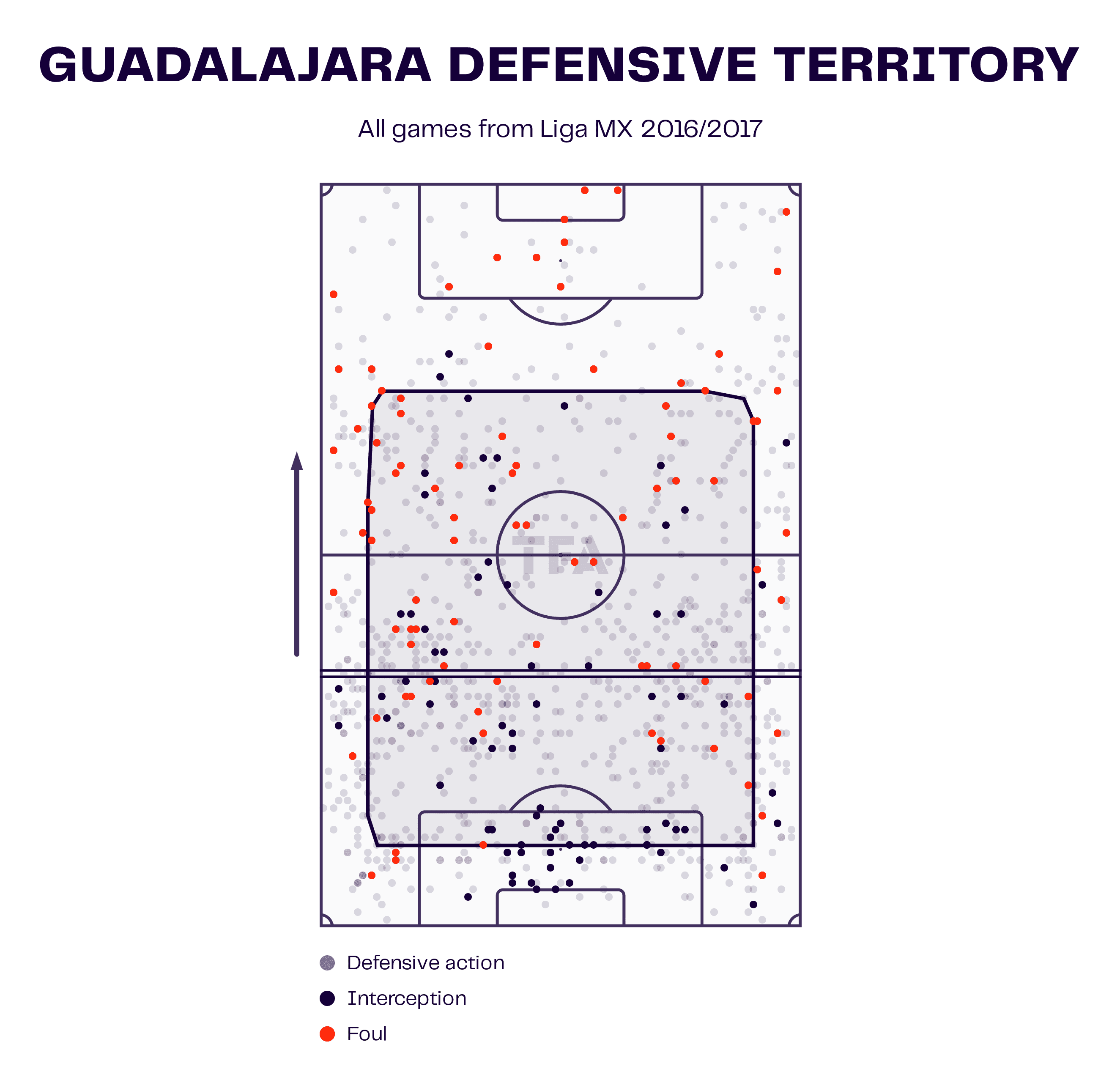
Conclusion
It is quite clear that, despite the results, Matías Almeyda was always seen by the teams he led in a good way.
He provided with him a philosophy and a basis to continue growing.
While projects like that of Guadalajara or San José give him years for his idea to continue flourishing and nourished by different aspects, the Argentine is now being able to adapt and fit in in a great way in Europe, as he has been doing in Greece.
It will be very important to see what will come for him at the end of the season to see if he manages to win a domestic title, such as the Cup or the Super League, and qualify for a European competition, a great and new challenge that he would have ahead of him.






Comments